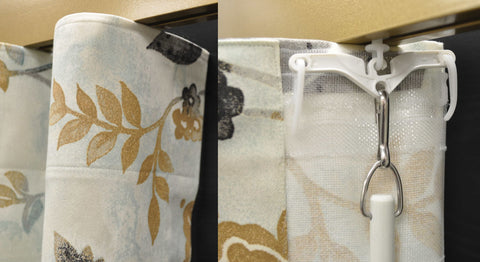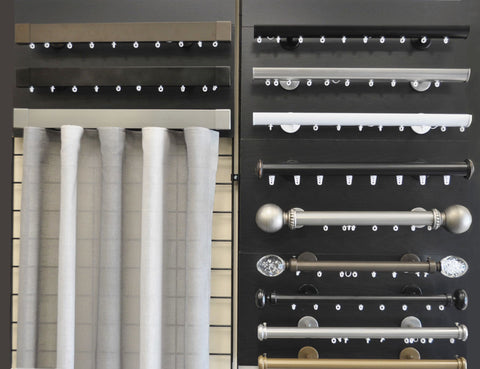Ripplefold Draperies Made Easy
Ripplefold Draperies Made Easy
To go straight to the pdf instruction pages, click the links below:
Wave fold custom drapery instructions with chart
Ripplefold custom drapery instructions with chart
Let's start by talking about the difference between a ripplefold drapery system and wave fold draperies (also known as S fold draperies). We sell both systems, but you may find our adaptation of the wave fold system offers more versatility than ripplefold drapery hardware. We now have a wave carrier option on almost all tracks that we carry. We have also written a more detailed comparison that just might convince you to try the Wavefold system. Catch the Wave!
Ripplefold Drapery
Ripplefold is a system started by the Kirsch company that uses a 1" wide snap tape sewn along the top of a flat drapery panel. The snaps on the ripplefold snap tape are always 4 1/4" apart for ripplefold drapes.


The ripplefold drapery track has carriers or slides running in the channel of the track. These carriers are connected by a string and held a set distance apart. This is what holds the fullness in the ripplefold curtain and prevents it from pulling flat when closed. We carry 4 different fullness ratio carriers. The 60% carrier is 2 5/8" apart, 80% carrier is 2 3/8" apart, the 100% carrier is 2 1/8" apart and the 120% is 1 7/8" apart. When using the 100% carrier that is 2 1/8" apart, a 2 to 1 fullness ratio is created because the snaps on the snap tape are double that distance at 4 1/4" apart. With the new style ripplefold carriers, a separate snap pendant is used to snap onto the snap tape and click into the carrier.


In our ripplefold instruction pdf we've taken much of the complexity out of ripplefold tracks. Ripplefold draperies are actually easy to make. The confusion comes in choosing what fullness ratio to use, which master carriers to use and how to add extra snaps at different distances for the master carriers. By eliminating master carriers, the ripplefold drapery rod becomes much easier, but remember that Ripplefold is an exact science. Everything must match up precisely.
Wave fold Drapery
Wave fold curtains use a special tape with loops. Plastic or metal hooks are used, instead of snap tape and snap pendants. It allows a lot more adjustability in determining the fullness ratio. The row of loops on the wave fold drapery tape is continuous, so it provides flexibility in spacing.



Instead of choosing from 4 different style(fullness) carriers, we use one at 2 3/8” spacing. The fullness is determined by the spacing of the hooks on the wavefold tape. The tape is usually clear and much wider than snap tape. It provides nice body for the folds at the top of the drapery.
The track styles for Ripplefold have been somewhat limited in the past but are improving. The Wave system option is available on almost every track we carry now. The fullness ratios are not limited to 4, but can be adjusted anywhere from 50% to 130% (and everything inbetween). This gives more flexibility. That said, the rod size determines the number of carriers, which in turn, determines the number of hooks. It’s just that you can adjust the spacing with wavefold, but not with ripplefold.
One added bonus with wavefold is the Neat Pleat Guide from Renaissance. It provides a place to attach a baton and helps to hold the first fold neatly in place.





